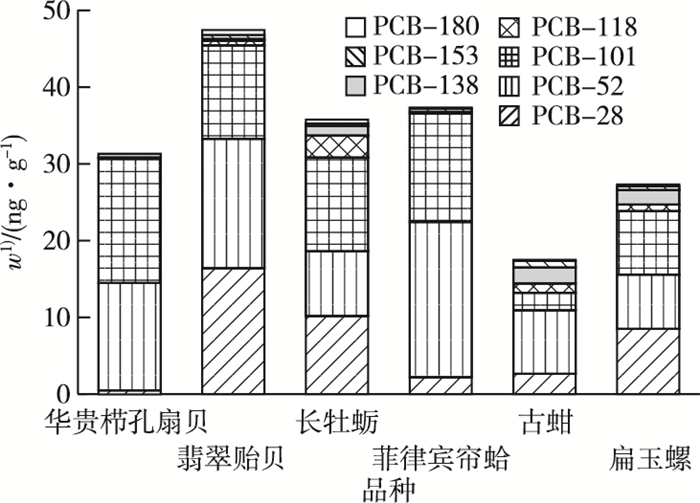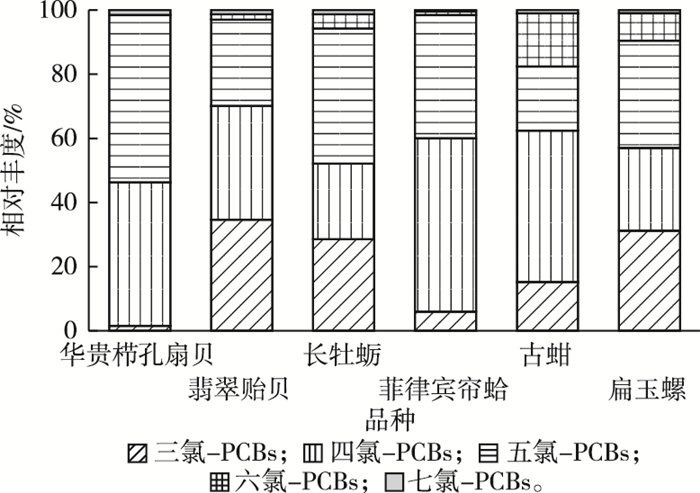多氯联苯(polychlorinated biphenyls, PCBs)是一类典型的持久性有机污染物, 拥有209种异构体。因为其优良的阻燃性、热稳定性、惰性和介电能力, PCBs曾被广泛用作阻燃剂、塑化剂以及变压器油[1-2]。在1998年被斯德哥尔摩公约列为优控污染物, 各国陆续采取了一系列的禁用措施[3-4], 但目前PCBs仍在各种环境介质中被广泛检出。
在过去的几十年里, PCBs的总产量大约为120万t, 约1/3的PCBs被释放进入环境中[5]。我国在20世纪60—70年代生产了约1万t PCBs作为变压器油(商品名称分别为1号和2号PCBs)[6-7]。尽管PCBs在2001年签署的斯德哥尔摩公约中被全面禁用, 其对环境的污染状况和人体健康风险仍需持续关注[8]。
2016年全国水产和海洋水产总量分别为6 901.25万和3 490.15万t, 其中海洋贝类产量为1 476.88万t, 分别占全国和海洋水产总量的21.4%和42.3%。华贵栉孔扇贝(Mimachlamys nobilis)、翡翠贻贝(Perna viridis)、长牡蛎(Crassostrea gigas)、菲律宾帘蛤(Ruditapes philippinarum)、古蚶(Anadara antiquata)和扁玉螺(Glossaulax didyma)是海口市场中常见贝类, 也是POPs生态影响的指示性物种。目前, 有关海口市售海洋贝类中PCBs存在状况、暴露水平和健康风险的研究还鲜有报道。
笔者采用气相色谱-质谱仪(GC-MS)测定了华贵栉孔扇贝、翡翠贻贝、牡蛎、菲律宾帘蛤、古蚶和海螺中7种指示性PCBs(PCB-28、PCB-52、PCB-101、PCB-118、PCB-138、PCB-153和PCB-180)含量, 分析了不同贝类中PCBs的组成特征和污染水平, 并评价其对人体的暴露水平和致癌风险。
1 材料与方法 1.1 试剂与材料7种指示性PCBs、回收内标2, 4, 5, 6-四氯-间二甲苯以及定量内标PCB-209的标准品购买自百灵威公司。硅胶(62~212 μm)购自上海泰坦科技股份有限公司; 碱性氧化铝(75~150 μm)购自北京华威锐科化工有限公司; 正己烷和二氯甲烷(色谱级)购自百灵威公司; 浓硫酸(分析级)购自天津市江天化工技术有限公司; 无水硫酸钠(分析级)购自天津市光复精细化工研究所。实验所用华贵栉孔扇贝、翡翠贻贝、长牡蛎、菲律宾帘蛤、古蚶和扁玉螺样品均于2017年夏季购于海口水产品综合批发市场, 每种品种分别采购20只。样品采集后, 冷藏运回实验室, 用小刀剥开外壳, 取出可食用部分, 而后用真空干燥机冻干, 研磨粉碎后, 置于棕色瓶内, -20 ℃条件下保存待用。
1.2 贝类样品的前处理参考文献[9-10], 准确称取2 g (精确到0.01 g)样品, 加入2 ng回收内标2, 4, 5, 6-四氯-间二甲苯, 而后分别加入15 mL正己烷和二氯甲烷(V:V=1:1), 超声提取20 min, 将上清液转移到梨形瓶中, 重复2次, 合并上清液。然后在40 ℃水浴下旋蒸至15 mL。并转移至分液漏斗中, 加入10 mL浓硫酸以除去样品中的脂质, 充分振荡后静置分层, 除去底层的硫酸, 重复4~5次, 直到上层有机相澄清。
将上层有机相放入100 mL梨形瓶, 用5 mL正己烷清洗分液漏斗合并入梨形瓶, 而后旋蒸至1~2 mL。将浓缩液转移到LC-Si固相萃取柱, 用9 mL正己烷和乙酸乙酯的混合溶液(V:V=19:1)分3次洗脱。将洗脱液氮吹至1 mL, 转移到色谱分析样品瓶中, 而后氮吹至近干, 加入2 ng定量内标PCB-209, 用正己烷定容至200 uL, 用GC-MS检测。
1.3 仪器分析PCBs的测定基于气相色谱-质谱联用仪(安捷伦7890B气相色谱串联5977A质谱)。色谱柱为DB-5MS (30 m×0.25 mm×0.25 μm)毛细管柱, 进样方式为不分流进样(进样量1 μL)。程序升温条件如下:初始温度为100 ℃, 保持2 min, 然后以15 ℃·min-1的速度升温至180 ℃, 再以3 ℃·min-1的速度升温至240 ℃, 最后以10 ℃·min-1的速度升至310 ℃, 保持10 min。离子源温度为230 ℃。载气为氮气, 柱流量为1 mL·min-1。PCBs单体的测定选择离子模式, 用内标法定量。各PCBs单体的定量和定性离子信息见表 1。
|
|
表 1 7种指示性PCBs定性和定量离子 Table 1 Qualitative and quantitative ion of 7 indicator PCBs |
为保证数据的可靠性, 进行了一系列质量控制实验, 包括平行样、程序空白实验、基质加标实验以及运用碳标记内标监测实验处理过程中单体的回收率。结果表明, 平行样(同一样品测定3次)中各单体的相对标准偏差小于30%。程序空白中7种PCBs单体含量均低于仪器检出限。表明基质加标实验(加标量为5和10 ng)中7种指示性PCBs单体的回收率为70%~120%。内标2, 4, 5, 6-四氯-间二甲苯的回收率为60%~130%。
1.5 贝类-沉积物生物累积模型贝类-沉积物生物累积模型(Biota-sediment accumulation model)常用于估算贝类体内污染物的浓度, 具体模型[11]为
| $ C{ _{贝类}} = \frac{{{C_{沉积物}} \times {f_{贝类}} \times {B_{{\text{saf}}}}}}{{{T_{沉积物}}}}。$ | (1) |
式(1)中, C贝类为贝类中PCBs单体含量, ng·g-1;C沉积物为沉积物中PCBs单体含量, ng·g-1;f贝类为贝类脂质含量, %;Bsaf为贝类-沉积物累积因子, 无量纲;T沉积物为沉积物中有机碳含量, %。
1.6 致癌风险评估模型应用USEPA推荐的健康风险评估模型评估海口海洋贝类中指示性PCBs对成人消费者的致癌风险, 计算公式为
| $ {T_{{\text{CR}}}} = \frac{{C \times {I_{摄入}} \times {E_{暴露频露}} \times {E_{暴露周期}}}}{{{W_{体重}} \times {A_{平均寿命}}}} \times {S_{\text{F}}}。$ | (2) |
式(2)中, TCR为海洋贝类中指示性PCBs对成人消费者的致癌风险;C为海洋贝类中7种指示性PCBs总含量, ng·g-1; SF为7种指示性PCBs的致癌斜率因子, 0.4 d·kg-1·mg-1[12]; I摄入为成人消费者每天的贝类摄入量, 1.66 g·d-1[11, 13]; E暴露频率为暴露频率, 365 d·a-1[14]; E暴露周期为暴露周期, 53 a[11]; W体重为成人体重, 60.6 kg; A平均寿命为平均寿命, 74.8 a。体重和平均寿命的参数来源于文献[15]。
2 结果与讨论 2.1 海口海洋贝类中指示性PCBs的含量7种指示性PCBs在海口市售贝6种贝类中均有检出(图 1), 总含量为17.51~47.43 ng·g-1 (以干重计, 下同), 平均为32.78 ng·g-1, 翡翠贻贝含量(47.43 ng·g-1)最高, 而古蚶(17.51 ng·g-1)最低。

|
图 1 海口6种市售海洋贝类中7种指示性PCBs含量 Figure 1 The concentrations of 7 indicator PCBs in seven kinds of marine molluscs from market of Haikou City 1)以干重计。 |
不同贝类中PCBs含量从高到低依次为翡翠贻贝>菲律宾帘蛤>长牡蛎>华贵栉孔扇贝>扁玉螺>古蚶。方差分析表明, 7种指示性PCBs在海口市售贝6种贝类中不存在显著性差异(P>0.05)。
2.2 海口海洋贝类中指示性PCBs的组成特征图 2为海口6种海洋贝类中指示性PCBs的组成特征。可以看出, 大多数贝类其组成主要以中、低氯代PCBs为主(三氯-PCBs、四氯-PCBs和五氯-PCBs)。四氯-PCBs是海口海洋贝类中指示性PCBs的最主要组分, 占总PCBs的38.49%。其次是五氯-PCBs, 其对总指示性PCBs的贡献率为35.51%, 这2种主要PCB单体对海口海洋贝类中总指示性PCBs的贡献率为74.00%。高氯代PCBs对海口海洋贝类中总指示性PCBs的贡献有限(< 10%)。这个结果与苏晴等[9]研究的10种主要海产品中7种指示性PCBs组成类似。四氯-PCBs是10种海洋水产中最主要的组分, 其次是五氯-PCBs。这与我国生产的PCBs结构有关。20世纪60—70年代我国共生产了1万t PCBs, 其中三氯-PCBs约9 000 t(商品名1号PCBs, 包含二氯-PCBs、三氯-PCBs和四氯-PCBs), 五氯约1 000 t(商品名2号PCBs, 包含四氯-PCBs、五氯-PCBs和六氯-PCBs)[6-7]。在7种指示性PCBs中, PCB-28和PCB-52在国产1号PCBs中的含量远大于其他5种单体, 因此其在环境中的含量也远远大于其他单体[6-7]。而五氯-PCBs被广泛用作油漆添加剂, 会通过大气尘降、废水排放等方式进入水体, 最终通过食物链富集在水生生物体内[16-17]。

|
图 2 海口市售贝类中指示性PCBs的组成特征 Figure 2 Composition characteristics of indicator PCBs in molluscs from market of Haikou City |
此外, 在不同种类的贝类中指示性PCBs的组成特征明显不同。柴继业等[18]也发现了同样的现象。通过模型可以看出, 贝类中污染物的含量和脂质含量与生存环境(沉积物)相关, 在不同贝类种类中指示性PCBs的差异是由生物影响因子、脂质含量及生存环境的PCBs污染程度与有机碳含量共同决定的。
2.3 海口海洋贝类中指示性PCBs的污染水平该研究中贝类PCBs含量高于天津渤海湾南排河海域脉红螺肌肉组织(8.4~10.06 ng·g-1, 以脂重计)[16]、闽江口附近牡蛎(0.05~0.26 ng·g-1,以湿重计)[18]、杭州地区酒店中贝类(0.04~0.25 ng·g-1,以湿重计)[19]以及宁波市售贝类(0.18~0.24 ng·g-1,以湿重计)[20], 但是低于厦门市售贝类〔(3.4±4.3) ng·g-1,以湿重计〕[21]、香港翡翠贻贝(38.6~303.01 ng·g-1,以干重计)[10]、宁波地区野生贝类(4.4~224.5 ng·g-1,以湿重计)[21]、台州近海贝类(5.52~80.64 ng·g-1,以干重计)[23]以及象山港海域经济贝类(13.54~22.57 ng·g-1,以湿重计)[23]。可见,海口市售海洋贝类中PCBs污染程度在我国处于中等水平。
2.4 海口海洋贝类中指示性PCBs对消费者的致癌风险海口市售6种贝类中指示性PCBs对成人消费者5%、50%以及95%致癌风险分别为1.46×10-7、2.44×10-7以及3.99×10-7。通常致癌风险小于10-6表明污染物对人群的致癌风险处于可接受风险水平, 当致癌风险处于10-6~10-4之间表明污染物对人群存在潜在的致癌风险, 而当致癌风险大于10-4时, 表明存在非常大的致癌风险[24-25]。海口市售贝类中指示性PCBs对消费者的总致癌风险远小于10-6, 表明其致癌风险处于可接受风险水平。
3 结论通过对海口市售6种海洋贝类中7种指示性PCBs的含量测定及其对消费者健康的风险评价, 得到了如下结论:
(1) 7种指示性PCBs在6种贝类中均有检出, 含量为17.51~47.43 ng·g-1, 平均含量为32.78 ng·g-1。贝类中指示性PCBs的组成以中低氯代PCBs(三氯-PCBs、四氯-PCBs和五氯-PCBs)为主, 其中四氯-PCBs是研究样本中指示性PCBs的最主要组分, 占总PCBs的38.49%。与我国同类研究数据相比, 研究样本中PCBs的总含量处于中等水平。
(2) 研究样本中指示性PCBs通过摄入途径暴露对成人消费者的5%、50%以及95%致癌风险分别为1.46×10-7、2.44×10-7以及3.99×10-7, 均小于10-6, 表明海口市售海洋贝类中PCBs对成人消费者的致癌风险处于可接受风险水平。
| [1] |
CACHADA A, LOPES L V, HURSTHOUSE A S, et al. The Variability of Polychlorinated Biphenyls Levels in Urban Soils From Five European Cities[J]. Environmental Pollution, 2008, 157(2): 511-518. (  0) 0) |
| [2] |
王磊, 龙涛, 陈樯, 等. 天然碳质吸附剂对典型有机污染物的吸附机制研究进展[J]. 生态与农村环境学报, 2015, 31(4): 452-459. [ WANG Lei, LONG Tao, CHEN Qiang, et al. Sorption Mechanisms of Typical Organic Pollutants on Natural Carbonaceous Geosorbents:A Review[J]. Journal of Ecology and Rural Environment, 2015, 31(4): 452-459.] (  0) 0) |
| [3] |
COGLIANO V J. Assessing the Cancer Risk From Environmental PCBs[J]. Environmental Health Perspectives, 1998, 106(6): 317-323. DOI:10.1289/ehp.98106317 (  0) 0) |
| [4] |
JAWARD F M, FARRAR N J, HARNER T, et al. Passive Air Sampling of PCBs, PBDEs, and Organochlorine Pesticides Across Europe[J]. Environmental Science & Technology, 2004, 38(1): 34-41. (  0) 0) |
| [5] |
HARRD S, HAZRATI S, IBARRA C. Concentrations of Polychlorinated Biphenyls in Indoor Air and Polybrominated Diphenyl Ethers in Indoor Air and Dust in Birmingham, United Kingdom:Implications for Human Exposure[J]. Environmental Science & Technology, 2006, 40(15): 4633-4638. (  0) 0) |
| [6] |
CUI S, QI H, LIU L Y, et al. Emission of Unintentionally Produced Polychlorinated Biphenyls (UP-PCBs) in China:Has This Become the Major Source of PCBs in Chinese Air?[J]. Atmospheric Environment, 2013, 67: 73-79. DOI:10.1016/j.atmosenv.2012.10.028 (  0) 0) |
| [7] |
降巧龙, 周海燕, 徐殿斗, 等. 国产变压器油中多氯联苯及其异构体分布特征[J]. 中国环境科学, 2007, 27(5): 608-612. [ JIANG Qiao-long, ZHOU Hai-yan, XU Dian-dou, et al. Characteristics of PCB Congeners and Homologues in Chinese Transformer Oil[J]. China Environmental Science, 2007, 27(5): 608-612. DOI:10.3321/j.issn:1000-6923.2007.05.008] (  0) 0) |
| [8] |
WANG Y, HU J, LIN W, et al. Health Risk Assessment of Migrant Workers' Exposure to Polychlorinated Biphenyls in Air and Dust in an E-Waste Recycling Area in China:Indication for a New Wealth Gap in Environmental Rights[J]. Environment International, 2015, 87: 33-41. (  0) 0) |
| [9] |
苏晴, 翁佩芳, 段青源, 等. 宁波海产品中多氯联苯的残留与风险评估[J]. 食品与生物技术学报, 2017, 36(4): 425-431. [ SU Qing, WENG Pei-fang, DUAN Qing-yuan, et al. Residual Characteristics of Polychlorinated Biphenyls in Seafoods in Ningbo and Health Risk Assessment[J]. Journal of Food Science and Biotechnology, 2017, 36(4): 425-431. DOI:10.3969/j.issn.1673-1689.2017.04.016] (  0) 0) |
| [10] |
孙成, 许士奋, 姚书春, 等. 香港海域翡翠贻贝(Perna viridis L.)中多氯联苯的研究[J]. 环境化学, 2003, 22(2): 182-188. [ SUN Cheng, XU Shi-fen, YAO Shu-chun, et al. Study on PCBs in the Green Mussel (Perna viridis L.) Samples in Hong Kong Marine Water[J]. Environmental Chemistry, 2003, 22(2): 182-188. DOI:10.3321/j.issn:0254-6108.2003.02.015] (  0) 0) |
| [11] |
LI J, DONG H, XU X, et al. Prediction of the Bioaccumulation of PAHs in Surface Sediments of Bohai Sea, China and Quantitative Assessment of the Related Toxicity and Health Risk to Humans[J]. Marine Pollution Bulletin, 2016, 104(1/2): 92-100. (  0) 0) |
| [12] |
USEPA.Mid Atlantic Risk Assessment, Regional Screening Level (RSL) Summary Table[R].Washington DC, USA: United States Environmental Protection Agency, 2017.
(  0) 0) |
| [13] |
QIAN Z Z, LUO F F, WU C Y, et al. Indicator Polychlorinated Biphenyls (PCBs) and Organochlorine Pesticides (OCPs) in Seafood From Xiamen (China):Levels, Distributions, and Risk Assessment[J]. Environmental Science and Pollution Research, 2017, 24(11): 10443-10453. DOI:10.1007/s11356-017-8659-4 (  0) 0) |
| [14] |
李丽娟, 温彦平, 彭林, 等. 太原市采暖季PM2.5中元素特征及重金属健康风险评价[J]. 环境科学, 2014, 35(12): 4431-4438. [ LI Li-juan, WEN Yan-ping, PENG Lin, et al. Characteristic of Elements in PM2.5 and Health Risk Assessment of Heavy Metals During Heating Season in Taiyuan[J]. Environmental Science, 2014, 35(12): 4431-4438.] (  0) 0) |
| [15] |
环境保护部. 中国人群暴露参数手册(成人卷)[M]. 北京: 中国环境出版社, 2013: 1-8.
(  0) 0) |
| [16] |
刘玥, 金芬, 安立会, 等. 渤海湾南排河海域脉红螺中多氯联苯的污染特征[J]. 环境化学, 2013, 32(8): 1463-1468. [ LIU Yue, JIN Fen, AN Li-hui, et al. Polychlorinated Biphenyls Distribution Pattern in Rapana venosa of Nanpai River Coast in Bohai Bay[J]. Environmental Chemistry, 2013, 32(8): 1463-1468.] (  0) 0) |
| [17] |
WAN Y, HU J, YANG M, et al. Characterization of Trophic Transfer for Polychlorinated Dibenzo-p-Dioxins, Dibenzofurans, Non-and Mono-Ortho Polychlorinated Biphenyls in the Marine Food Web of Bohai Bay, North China[J]. Environmental Science & Technology, 2005, 39(8): 2417-2425. (  0) 0) |
| [18] |
柴继业, 唐子刚, 史西志, 等. 基于QuEChERs-GC/ECD快速检测贝类中有机氯农药及多氯联苯残留[J]. 水产养殖, 2018, 39(1): 29-35. [ CAI Ji-ye, TANG Zi-gang, SHI Xi-zhi, et al. Simultaneous Analysis of Polychlorinated Biphenyls and Organochlorine Pesticides in Marine Products by QuEChERS Coupled With GC-ECD[J]. Journal of Aquaculture, 2018, 39(1): 29-35. DOI:10.3969/j.issn.1004-2091.2018.01.006] (  0) 0) |
| [19] |
钟硕良, 蔡玉婷, 董黎明, 等. 海水养殖贝类体中TPH和PCBs的分布和积累研究[J]. 海洋水产研究, 2008, 29(2): 82-89. [ ZHONG Shuo-liang, CAI Yu-ting, DONG Li-ming, et al. Study on the Distribution and Accumulation of TPH and PCBs in Maricultured Bivalves[J]. Marine Fisheries Research, 2008, 29(2): 82-89.] (  0) 0) |
| [20] |
张双凤, 韩见龙, 徐小民, 等. 冷冻海产品中多氯联苯的污染研究[J]. 中国卫生检验杂志, 2009, 19(2): 406-407. [ ZHANG Shuang-feng, HAN Jian-long, XU Xiao-min, et al. Study on Polychlorinated Biphenyls Level in Frozen Seafood[J]. Chinese Journal of Health Laboratory Technology, 2009, 19(2): 406-407.] (  0) 0) |
| [21] |
施家威, 李和生, 王玉飞. 2007-2008年宁波地区海产品中多氯联苯污染状况分析[J]. 中国预防医学杂志, 2010, 11(1): 62-65. [ SHI Jia-wei, LI He-sheng, WANG Yu-fei. Study on Polychlorinated Biphenyls Pollution Levels and Dynamics in Ningbo Seafood, 2007-2008[J]. China Preventive Medicine, 2010, 11(1): 62-65.] (  0) 0) |
| [22] |
葛蔚涛, 江锦花, 陶亮, 等. 台州近海养殖贝类体内多氯联苯的污染特征及评价[J]. 台州学院学报, 2015, 37(3): 1-7, 11. [ GE Wei-tao, JIANG Jing-hua, TAO Liang, et al. The Concentrations and Risk Assessment of Polychlorinated Biphenyls (PCBs) in Shellfishes From the Breeding Environment in Taizhou[J]. Journal of Taizhou University, 2015, 37(3): 1-7, 11.] (  0) 0) |
| [23] |
任敏, 叶仙森, 项有堂. 象山港经济贝类中有机氯农药和多氯联苯的残留水平及其变化趋势[J]. 海洋环境科, 2006, 25(2): 48-50. [ REN Min, YE Xian-sen, XIANG You-tang. Concentrations and Trend of Organochlorine Pesticides and Polychlorinated Biphenyls in Economic Seashell Collected From Xiangshan Harbour Aera[J]. Marine Environmental Science, 2006, 25(2): 48-50. DOI:10.3969/j.issn.1007-6336.2006.02.013] (  0) 0) |
| [24] |
USEPA.Supplemental Guidance for Developing Soil Screening Levels for Superfund Sites[R].Washington DC, USA: United States Environmental Protection Agency, 2002.
(  0) 0) |
| [25] |
USEPA.Risk Assessment Guidance for Superfund Volume I: Human Health Evaluation Manual (Part F, Supplemental Guidance for Inhalation Risk Assessment)[R].Washington DC, USA: United States Environmental Protection Agency, 2009.
(  0) 0) |




